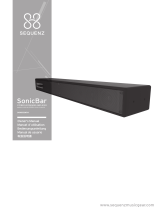
7 En
4 SPEAKERS selector
Turns on or off the sets of speakers connected to the
SPEAKERS L/R CH A and/or B terminals on the rear
panel, as follows.
OFF: Both sets of speakers are off.
A/B: The set of speakers connected to the A or B
terminals is on.
A+B BI-WIRING: Both sets of speakers are on.
If you use two sets (A and B), the impedance of each speaker
must be 8 or higher.
5 METER selector
Switches the meter function as follows:
OFF: Turns off the meter and the illumination.
PEAK: The meter functions as a peak level meter.
The peak level meter shows a momentarily highest
audio output level.
VU: The meter functions as a VU (Volume Unit) level
meter. The VU level meter shows an effective
audio output value that is similar to human senses.
6 Meters (LEFT/RIGHT)
Show the audio output level of the left (LEFT) and
right (RIGHT) channels in VU or PEAK meter mode.
The VU or PEAK meter can be selected by the
METER selector.
7 BASS control
Adjusts the volume level of the bass range.
Control range: –10 dB to 0 to +10 dB
8 TREBLE control
Adjusts the volume level of the treble range.
Control range: –10 dB to 0 to +10 dB
9 BALANCE control
Adjusts the audio output balance of the left and right
speakers to compensate for sound imbalances caused
by speaker locations or listening room conditions.
• When both the BASS and TREBLE controls are set to the 0
position, audio signal bypasses the tone control circuitry.
• Adjusting the BASS, TREBLE, and BALANCE controls does
not affect input signals at the MAIN IN jack and output signals
at the LINE 2 REC jack.
Caution
Notes
English





















